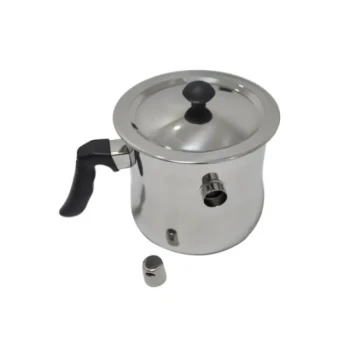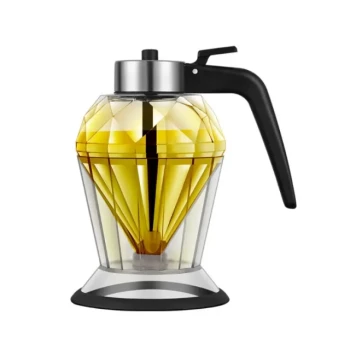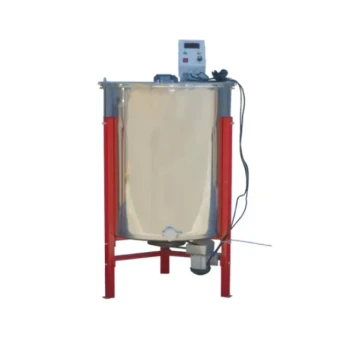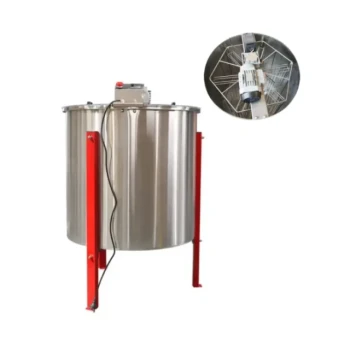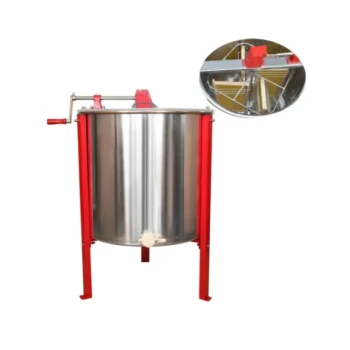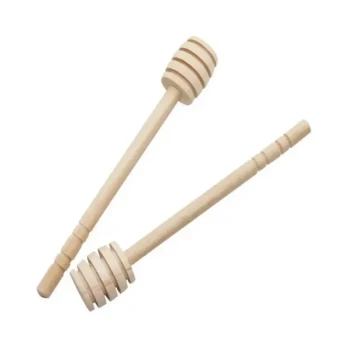To restore crystallized honey, the most reliable method is to gently warm the honey container in a bath of hot water. As the honey warms, the glucose crystals will dissolve back into the solution, returning it to a smooth, liquid state. The key is to apply low, indirect heat to avoid damaging the honey's delicate flavor and beneficial properties.
Honey crystallization is a natural process, not a sign of spoilage. The key to restoring its liquid texture is applying gentle, controlled heat to dissolve the sugar crystals without damaging the honey's delicate flavor and aroma.
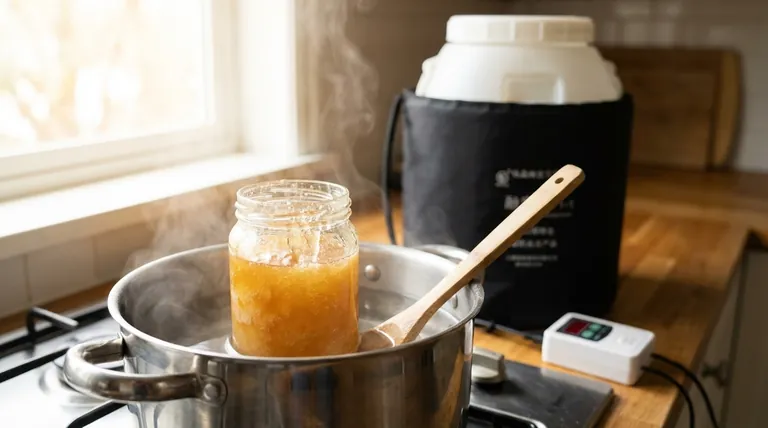
Why Honey Crystallizes in the First Place
A Natural Process, Not Spoilage
The granulation of honey is a natural characteristic of pure, unprocessed honey. It is not an indication that the honey has gone bad or is of poor quality; in fact, it often serves as proof that the honey is authentic.
The Science of Supersaturation
Honey is a supersaturated solution, meaning it contains more dissolved sugar (primarily glucose and fructose) than water can naturally hold. Over time, the less-soluble glucose will separate from the water and form tiny crystals.
Catalysts for Crystallization
This process can be accelerated by several factors, including the honey's specific glucose-to-fructose ratio, the presence of small particles like pollen or wax, and, most significantly, temperature.
The Correct Method for Re-liquefying Honey
The Stovetop Water Bath (For Glass Jars)
This method offers the most control. Place your open glass jar of honey into a saucepan. Fill the pan with enough water to surround the honey, but not so much that it could splash into the jar.
Gently heat the water on a low setting. Do not let the water boil. As the honey warms, stir it occasionally to distribute the heat and speed up the process. Once the crystals have dissolved, remove the jar and let it cool.
The Hot Water Bowl (For Plastic or Glass Jars)
If your honey is in a plastic container, or if you prefer a gentler approach, this is the safest option. Simply place the container in a bowl and fill the bowl with hot tap water.
This will take longer, and you may need to replace the water as it cools, but it virtually eliminates the risk of overheating the honey or melting the plastic.
Understanding the Trade-offs: What to Avoid
The Danger of Overheating
Excessive heat is the primary enemy of quality honey. If honey gets too hot, its sugars will begin to caramelize, which permanently alters its flavor and darkens its color.
Furthermore, high temperatures can destroy the beneficial enzymes and antioxidants that are naturally present in raw honey, diminishing its unique properties.
Why Microwaving Is Not Recommended
Microwaving is a poor choice for re-liquefying honey because it heats unevenly and far too quickly. It creates intense "hot spots" that will scorch and damage parts of the honey before the rest of the jar has even begun to warm up.
How to Apply This to Your Project
Before attempting to fix your honey, consider your container and your priority.
- If your primary focus is preserving flavor and nutrients: Use the slowest method by placing the jar in a bowl of hot tap water, replacing the water as needed.
- If your primary focus is speed (with a glass jar): Use a stovetop water bath on the lowest heat setting, stirring frequently and removing the jar as soon as the crystals are gone.
- If your honey is in a plastic container: Never use direct stovetop heat. Stick to the hot water bowl method to avoid melting the plastic and contaminating the honey.
By understanding this natural process, you can easily restore your honey to its perfect state anytime it crystallizes.
Summary Table:
| Method | Best For | Key Steps |
|---|---|---|
| Stovetop Water Bath | Glass jars, faster results | Place jar in pan of warm (not boiling) water; stir occasionally. |
| Hot Water Bowl | Plastic or glass jars, maximum safety | Submerge container in a bowl of hot tap water; replace water as it cools. |
For commercial apiaries and distributors, proper honey handling is essential for product quality. HONESTBEE supplies durable, high-quality beekeeping equipment—including honey warming cabinets and heat-resistant containers—designed to help you manage crystallization efficiently at scale. Let us help you protect your product's integrity. Contact our wholesale experts today to discuss your operation's needs.
Visual Guide
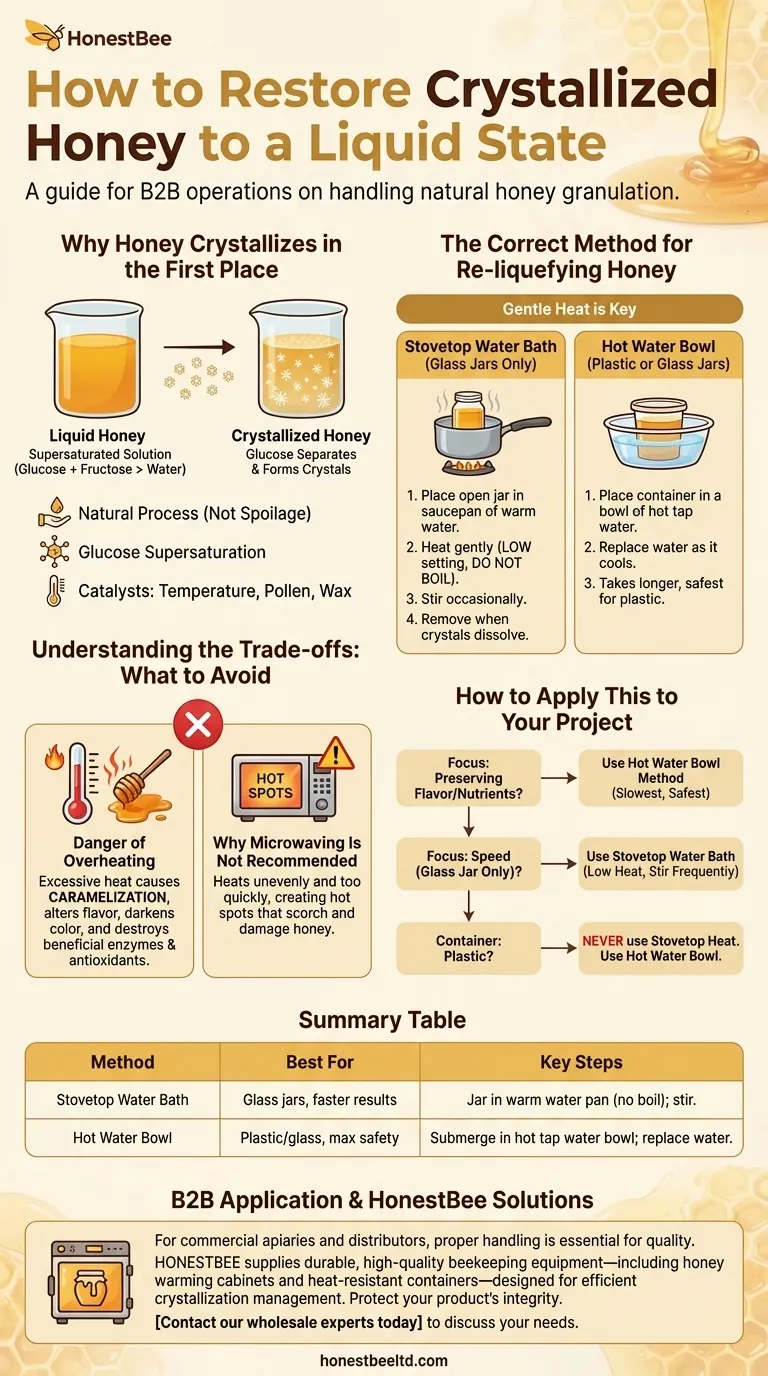
Related Products
- Honey Tank Heater Drum Heating Blanket for Honey Barrel
- Honey Concentrating and Filtering Dehumidifier Machine 2T Capacity for Honey
- 10L Stainless Steel Electric Honey Press Machine
- Electric Honey Press Machine for Squeezing Honey Comb Press Equipment
- Silicone Rubber Honey Drum Heating Belt
People Also Ask
- How to fix solidified honey? A Beekeeper's Guide to Gentle Re-liquefaction
- What are the benefits of a honey heating tank? Achieve Crystal-Clear, Market-Ready Honey
- How do you use a honey warmer? A Guide to Safe, Gentle Honey Decrystallization
- How many times can you decrystallize honey? The truth about quality loss with each cycle.
- What are the methods for heating honey? Preserve Quality and Improve Workability





